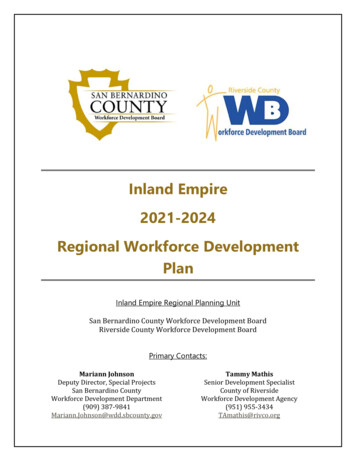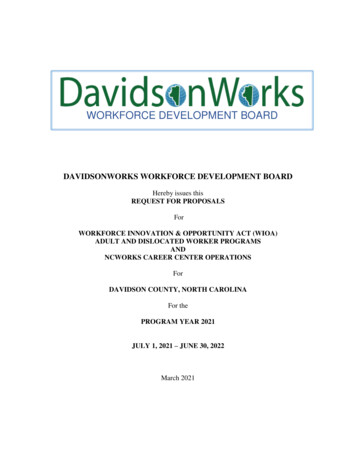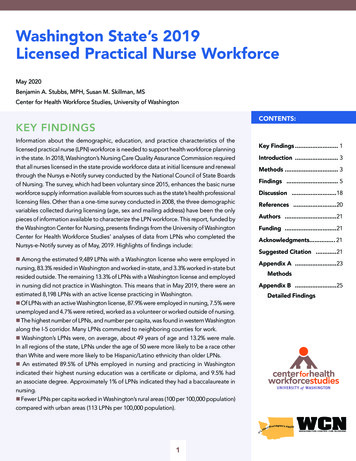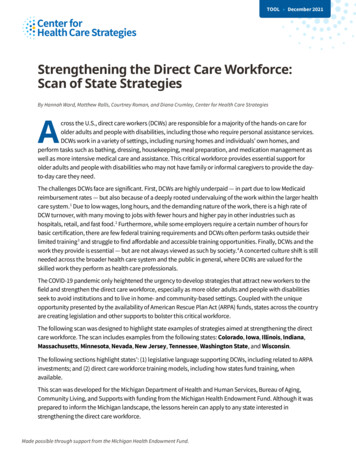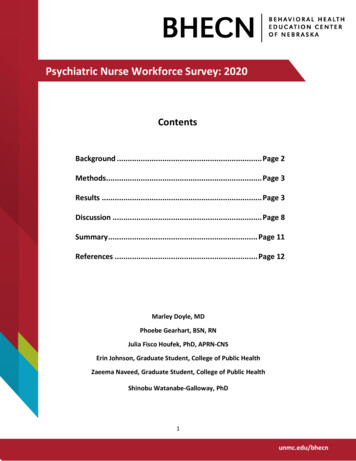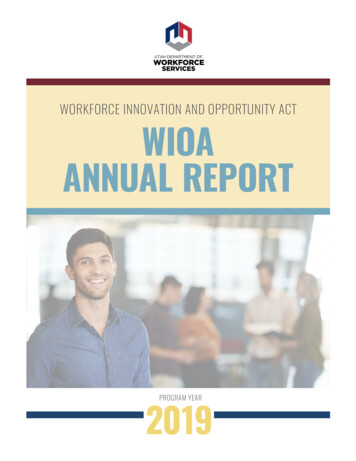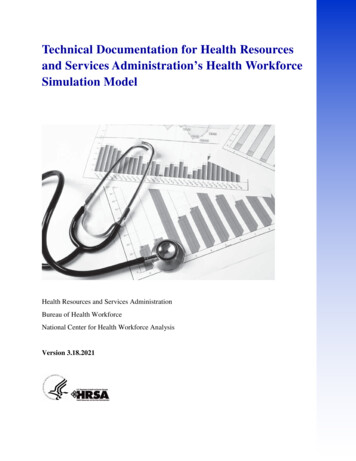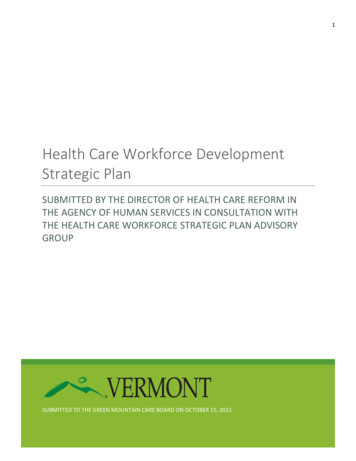
Transcription
1Health Care Workforce DevelopmentStrategic PlanSUBMITTED BY THE DIRECTOR OF HEALTH CARE REFORM INTHE AGENCY OF HUMAN SERVICES IN CONSULTATION WITHTHE HEALTH CARE WORKFORCE STRATEGIC PLAN ADVISORYGROUPSUBMITTED TO THE GREEN MOUNTAIN CARE BOARD ON OCTOBER 15, 2021
2ContentsPrimary Charge .3Executive Summary .4Introduction .5Coordination of Health Care Workforce Development Activities in the State of Vermont .6Data and Monitoring .7Financial Incentives for Health Care Workers Living and Working as Permanent Employees in Vermont .8Offsetting Educational Costs .8Table I: Inventory of Existing Scholarship and Loan Forgiveness Programs . 10Promoting Permanent Employment with Vermont Employers . 10Chart I: Growth in Vermont SNF Expenses for Traveling Staff . 11Education and Training . 13Regulation. 16Practice . 18Recruitment and Retention . 19State of Vermont-Based Support for Worker Recruitment and Retention . 19Employer-Based Recruitment and Retention . 20Federal Policy . 22Future Considerations . 23Appendix A: Health Care Workforce Strategic Plan Advisory Group . 24Appendix B: Licensed Provider Census Data by Provider Type . 25Appendix C: Vermont Healthcare Workforce Development Stakeholders and Programs . 26
3Primary ChargeAct 155 of 2020, An act relating to increasing the supply of nurses and primary care providers in Vermont,establishes that,The Director of Health Care Reform in the Agency of Human Services shall maintain a current health careworkforce development strategic plan that continues efforts to ensure that Vermont has the health careworkforce necessary to provide care to all Vermont residents.In maintaining the strategic plan, the Director or designee shall consult with an advisory group composed ofthe following 11 members, at least one of whom shall be a nurse, to develop and maintain the strategic plan: one representative of the Green Mountain Care Board’s primary care advisory group;one representative of the Vermont State Colleges;one representative of the Area Health Education Centers’ workforce initiative;one representative of federally qualified health centers;one representative of Vermont hospitals;one representative of physicians;one representative of mental health professionals;one representative of dentists;one representative of naturopathic physicians;one representative of home health agencies; andone representative of long-term care facilities.The Director or designee shall serve as the chair of the advisory group. Attachment A includes a list ofrepresentative participants.
4Executive SummaryWe submit the following Health Care Workforce Development Strategic Plan with gratitude and appreciationfor all members of the health care workforce who have provided care and comfort to Vermonters and havedemonstrated resilience throughout the COVID-19 global health pandemic.The following plan focuses on workforce development for nurses, primary care physicians, dental careproviders, and mental health and substance use disorder treatment professionals working in all settingsincluding acute care, long-term care, medical office, in-home, community-based, dental, and mental health andsubstance use disorder treatment settings.The advisory group explored a large range of topics and arrived at a comprehensive assessment of health careworkforce development challenges and opportunities in the following areas: Coordination Data and Monitoring Financial Incentives Education and Training Regulation Practice Recruitment and Retention Federal PolicyThe strategic plan includes recommendations for action and designates an accountable entity in all the domainslisted above. Accountable entities should approach their tasks using an equity lens, meaning they shouldidentify how current policies and programs may systematically exclude some Vermonters based on race, age,gender, sexual orientation, immigration status, disability, or the rurality of where they live and how reforms canachieve the State’s workforce goals while advancing health and social equity. The Health Equity Commissionas established in Act 33 of 2021 could be a resource to accountable entities for determining program impacts onhealth equity.The plan acknowledges that future work is necessary to delve more deeply into the barriers for non-licensedallied health, direct support professionals (e.g. personal care attendants and home care aides), peers andcommunity health workers to join the workforce since this sector is inadequate to meet the service needs ofVermonters of all ages with disabilities and mental health and substance use disorder needs.This plan will rely on coordination to implement solutions that span state government, health care educators,training and recruitment centers, private employers, and employees. As a hopeful foreshadowing of theimmediate and ongoing work necessary to implement this plan, the approach to crafting the recommendationswas collaborative, cooperative and creative. Thank you to the advisory group members and the state and privateemployees who contributed to the following Health Care Workforce Development Strategic Plan.
5IntroductionIn January 2020, the Rural Health Services Task Force established by Act 26 of 2019, submitted a report andrecommendations for improving Vermont’s health care, long-term care, mental health and substance usedisorder treatment and dental workforce to the Legislature. The report stated that “Providers highlight needs fornearly all professions from unlicensed personal care attendants and direct support professionals to mental healthand substance use disorder professionals, to physicians. These individuals work in a variety of settings, acrossmultiple levels of care including but not limited to hospitals, federally qualified health centers, independentphysician practices, long-term care facilities, designated agencies, adult day providers and home healthagencies.”1Pre-pandemic staffing challenges have been exacerbated by the COVID-19 global health pandemic. Every tasktakes additional staff time and resources due to heightened infection control protocols and other measures thatare likely to be implemented well into the future. Donning and doffing of full PPE between patients, cleaningprotocols, quarantine procedures, visitor screening and monitoring of visitation all add necessary and critical,but time consuming, work. More staff are needed to complete routine tasks in all types of health care includingacute care, long-term care, medical office, in-home, community-based, dental, and mental health and substanceuse disorder treatment settings. Staff have left the health care profession due to fear, the need to care forchildren or relatives, and burnout throughout the pandemic. In addition, staff who contract COVID cannot workuntil they are recovered, further reducing staffing levels.The United States Chamber of Commerce Reports, “In several states and several industries, including hard-hitsectors like education and health services as well as professional and business services, there are currently feweravailable workers than the total number of jobs open.” spite-of these staffing challenges, Vermont has led the nation in its COVID-19 response, consistentlymaintaining one of the lowest infection rates in the country and one of the highest vaccination rates, all of whichhave allowed the state to avert the COVID-19 surges seen elsewhere. Still, the health care system has requiredan unsustainable increase in the use of contract and traveling staff to maintain access to high quality care. Thecost of travelers continues to dramatically increase and has reached unsustainable levels. Costs are being drivenby the workforce shortage, and travelers, in great demand throughout the country, are more difficult to accessbecause of rising costs. Challenges associated with maintaining an adequate workforce have increased whileVermonters are requiring care for more complex and serious conditions, including mental health and substanceuse dependency conditions. To meet emerging need, organizations have pooled and deployed staffing resourcesto alleviate acute shortages.Wait times for health care services had emerged as a critical concern pre-pandemic and the concern hasheightened during the pandemic. The Agency of Human Services (AHS) is leading an investigation into waittimes for health care services statewide and is collaborating with the Department of Financial Regulation andthe Green Mountain Care Board. The initiative will develop and establish key metrics for wait times, collectstandard information for comparison across the system, and conduct a qualitative analysis to determine whatfactors are driving increased wait times for health care services. Although anecdotal until confirmed through theinvestigation, workforce supply has been cited as a contributor to longer-than-appropriate wait times for health1Retrieved from: ce%20White%20Paper%20FINAL%201.23.20.pdf on October 14, 2021.
6care services. Importantly, the wait time investigation will seek to understand all factors that may becontributing to longer-than-acceptable wait times for health care services and propose relevant solutions.This strategic plan builds on and updates recommendations from the Rural Health Services Task ForceWorkforce Subcommittee Report of 2020. The 2021 strategic plan focuses on strategies to improve theavailability of nurses, primary care physicians, dental care providers, and mental health and substance usedisorder treatment professionals and recommends future work to delve more deeply into the barriers for nonlicensed allied health, direct support professionals (e.g. personal care attendants and home care aides), peers andcommunity health workers to join the workforce as this sector of the workforce is also inadequate to meet theservice needs of older and disabled Vermonters. The document names issues and recommends solutions in thefollowing domains: CoordinationData and MonitoringFinancial IncentivesEducation and TrainingRegulationPracticeRecruitment and RetentionFederal PolicyCoordination of Health Care Workforce Development Activities in the State of VermontTo move the strategic plan from recommendation to action, the advisory group proposes the followingstructures to support coordination between multiple stakeholder groups while assigning responsibility forimplementation. Establish a state interagency task team. In the near-term, establish a state interagency task team toensure that existing resources and expertise are applied to those recommendations that require additionalprocess for development, coordination, and implementation. At a minimum the task team shouldinclude: The Agency of Human Services, The Agency of Administration, The Agency of Commerce andCommunity Development, the Department of Labor, The Agency of Education, and the State ChiefPrevention Officer. The task team should include the Director of Health Care Reform as liaison to theadvisory group responsible for maintaining this strategic plan. The team should consult with otherAgencies and Departments as needed. Integrate the Health Care Workforce Strategic Plan Advisory Group with the State WorkforceDevelopment Board. The Health Care Workforce Strategic Plan Advisory Group (Advisory Group)should also serve as an official sub-committee to the State Workforce Development Board. Integratingthe Advisory Group in this manner will ensure that the strategic plan implementation is aligned withbroader workforce development initiatives. This recommendation is consistent with recommendationsfrom the Rural Health Task Force Workforce Subcommittee Report of 2020.
7Section Summary: Coordination of Health Care Workforce Development Activities in the State of VermontAdvisory Group RecommendationAction Required ByEstablish State Interagency Task TeamIntegrate with State Workforce Development Board(State Workforce Development Board)AHSSWDBData and MonitoringAs indicated in the Rural Health Task Force Workforce Subcommittee Report, “several State agencies and aprivate entity are responsible for collecting current statewide workforce data.” As specified by the report, theseinclude: Department of Labor: Economic and Labor Market Information DivisionDepartment of Health: Health Statistics and Division of Health SurveillanceUVM Larner College of Medicine: Area Health Education Center (AHEC)Secretary of State: Office of Professional RegulationThe Department of Health, in partnership with the Office of Professional Regulation and the Board of MedicalPractice, administers a census that is mandatory for licensed health care professionals to take at the time oflicense renewal, which depends upon profession and occurs every two years.2 The census captures a snapshot ofindividual providers and some details of their specific practices in Vermont but is unable to give insight intoworkforce supply for non-licensed professionals, such as direct support professionals and peers, who also playcritical roles in ensuring the availability of services across the health care continuum, participating ininterdisciplinary teams and implementing care plans.Aggregated data from these censuses administered by the Department of Health and nursing data from AHEC3are available in Appendix B. Both the Department of Health and healthcare professionals have experiencednormal workflow disruption due to the current coronavirus pandemic, so typical reporting of the census hasbeen delayed even though data collection has continued.Census data for licensed provider types is an important building block for monitoring Vermont’s health careworkforce but this data needs to be paired with additional information to paint a picture of Vermont’s workforceneeds. First, census data should be compared to meaningful benchmarks that capture state-specific and regionalfactors (e.g. demographics). There are geographic variances for each profession or group of professions andsome regions have greater or lesser needs than others. These variations should be taken into consideration formeaningful benchmarking. Finally, census data should become an input to supply and demand modeling thatcan be used by health care employers, health care educators, and policy makers.Determining the adequacy of the workforce is integral to identifying those disciplines or geographic regions thatare at risk of having a significant imbalance between demand and supply. An aging population, an agingworkforce, burnout related to the pandemic and increased demands related to infectious disease are just a fewvariables that point to a potential shortage of professionals. Understanding where gaps may exist between thecurrent demand for healthcare workers and the available supply may assist in identifying areas of priority forpolicy makers.2More information can be found at the Vermont Department of Health website located at: re-workforce3Retrieved from nt/reports on October 14, 2021.
8A dynamic supply and demand model is necessary and should factor in drivers and data points such as employerand patient needs, employer vacancies, employer projections, aging of the population, retirement of health careprofessionals, changes in treatment modalities, trends in health care outcomes, and the capacity of Vermont’sacademic institutions that graduate healthcare workers. Census data alone cannot be used to inform supply sinceit includes those who are licensed in Vermont but may not practice in Vermont.To understand what barriers academic institutions may be experiencing, they could be queried to determinetheir current capacity, the presence of a waiting list, faculty vacancies, and retention percentages for theirgraduates. Although not the exclusive producer of healthcare professionals, it would be helpful to understandwhat opportunities there are for assisting academic centers to increase their capacity and encouraging graduatesto remain in the state. Resources would be required for new data collection, compilation and reporting of thisinformation.Recommendation for Action: Identify a lead state entity as the health care workforce data hub. The coordinated interagency taskteam should identify a lead state entity as the health care workforce data hub that focuses on the healthcare, long-term care, mental health and substance use disorder treatment and dental workforce. Thisentity should be responsible for aggregating all relevant workforce data, including data from Vermont’sTalent Pipeline. The entity should identify data gaps, such as with unlicensed providers and directsupport professionals, collect new data, and issue regular monitoring reports no more than every twoyears.Employ supply and demand modeling. The health care workforce data hub should explore andrecommend an ongoing process and necessary funds for health care workforce supply and demandmodeling for use by health care employers, health care educators, and policy makers. This supply anddemand modeling could become an input to the Green Mountain Care Board’s Health ResourceAllocation Plan.Section Summary: Data and MonitoringAdvisory Group RecommendationIdentify lead state entity as health care workforce datahubEmploy supply and demand modelingAction Required ByInteragency task teamHealth care workforce data hubFinancial Incentives for Health Care Workers Living and Working as Permanent Employees inVermontOffsetting Educational CostsThe 2020 Rural Health Services Task Force report indicates the rising cost of higher education for health careprofessionals as a barrier to growing the pool of health care professionals working in Vermont. The reportstates,Nationally, medical school tuition has risen 56% for in-state public school, and 47% for private schools since2009. At the University of Vermont Larner College of Medicine, Vermont’s only medical school, tuition is 37,070 for in-state students and 64,170 for out-of-state students. This is above the national average instate/out-of-state tuition of 31,905/ 55,291 for public medical schools.The cost of nursing school has also risen significantly. At the University of Vermont, tuition for a BSN has risen48% since 2009. At Castleton University, nursing school tuition has risen 85% for in-state students. This
9exceeds the national average of a 37% increase for in-state public schools, and 26% rise for private schoolsover the past decade.The Mental Health and Substance Use Disorder workforce includes multiple provider types with degrees thatrange from a bachelor’s level degree up to a doctoral degree. Licensure requirements for mental healthprofessionals include specific mastered degree types, supervised practice, and exams. The national averageannual undergraduate tuition, fees, room and board rates have increased 21% from 20,947 to 25,281 between2009 and 2019.4 Graduate tuition and required fees have risen 33% during this timeframe from 14,542 in 2009to 19,292 in 2019.5 Licensed professionals are also required to pay fees for up to 60 continuing educationcredits every two years depending on profession and biannual licensure fees adding to the costs of practicing inthese professions.As indicated in Table I below, the following programs of loan repayment, loan forgiveness and studentincentive scholarships are currently available to help offset education costs for health care professionalsworking in Vermont. These programs include service agreements that require recipients to practice in the State,sometimes in particular health service areas or health centers. AHEC’s Loan Repayment program is highlycompetitive and limited. In 2019, only 59% of applicants received awards. Loan repayment dollars have largelybeen allocated to MDs and APRNs making limited funding available to RNs and LPNs.Also indicated in Table I, not all financial assistance programs have ongoing funding streams and someprograms are subject to annual appropriations. The lack of consistent funding for these programs makes itdifficult to assess and plan for how funds may be directed to those health care professionals for which there isan emerging workforce need or for those health care professionals who have historically been excluded fromeligibility (e.g. naturopathic practitioners).Recently, the American Rescue Plan Act (ARPA) afforded the National Health Service Corps the ability toincrease the number of awards to licensed providers and health profession students by adding 800 million tothe existing program. Given the infusion of this funding, the National Health Service Corps aims to award alleligible applicants. This means that clinicians working at sites with lower Health Professional Service Areascores, which has traditionally been a barrier to accessing these programs in Vermont, are expected to have theirapplications funded.4Retrieved from: 0 330.10.asp on October 14, 2021.5Retrieved from: 0 330.50.asp on October 14, 2021.
10Table I: Inventory of Existing Scholarship and Loan Forgiveness ProgramsIncentive Type# ofProvidersAwarded1Per YearService Obligation perone year of Award.Max years to receive.Award SizeTotal FundingSourceSLRP Educational LoanRepayment for MD, DO, PA,APRN, DDS, DMD at FQHCs20-251 year in a VermontHPSA2. Max 6 yrs. 20,00040,000 425,00050% Federal, 50% match2ELR Loan Repayment for MD,DO, PA, APRN, DDS, DMD75-851 year in Vermont. Max6 yrs. 20,00040,000 1,034,22250% State/Federal, 50%match3ELR Loan Repayment for RN,LPN251 year in Vermont. Max4 yrs. 6,00010,000 150,000State/Federal, match is rareTuition Assistance for Staff ofDesignated Mental HealthAgenciesTBD1 year in VermontTBD 1,500,000StateIncentive Scholarship/LoanForgiveness for Dental students(2nd, 3rd, and 4th year dentalstudents are eligible)2-31 year in Vermont. Max3 yrs. 25,000 50,000StateIncentive Scholarship/LoanForgiveness for MD students atUVM (3rd and 4th year medicalstudents are eligible)up to 101 year in Vermontoutside of ChittendenCounty. Max 2 yrs. 40,000 1,236,770StateScholarships for Nurses150-2001 year in Vermont 6,000 1,035,957StateNHSC Loan Repayment forMD, APRN, LPN, RN, LADC,DDS, LCSW4-8052 Years in a VermontHPSA 12,500 25,000Apr. 1,750,000Federal1Some awards are declined or ineligible after award offer.Health Professional Shortage Area: tage-designation#hpsas VT rarely qualifies for HPSA’s however FQHC’s automatically aretreated as being in a HPSA by HRSA.3Employer Match4Split between State and Employer Match5NHSC is a program for which Vermont is not typically competitive for. In the last typical year (2018) VT received 1 NHSC award. Occasionally HRSA makes significant temporary investmentsto meet acute national crisis. Beginning in 2019 with investments aimed at the Opioid response and then continuing with Covid-19 response efforts, lower scored (better served) locationshave been able to qualify for NHSC awards. In 2019 VT received 16 awards; 14 in 2020, and 43 in 2021.2Promoting Permanent Employment with Vermont EmployersBy the end of 2021 Vermont’s hospitals6 are projecting to have spent more than 75 million dollars on nonemployed, temporary, traveling staff hired through staffing agencies. In a communication to the AdvisoryGroup, the Vermont Association of Hospitals and Health Systems reported that “Vermont providers continue toleverage staffing agencies more than ever; from hospital fiscal year 2020 to projected 2021, the use of travelersfor hospitals who have reported information has increased 26% from 270 to 341 positions while hospital costsassociated with these services has increased 50% from 50 million to 75 million.”6This includes hospitals regulated by the Green Mountain Care Board Hospital Budget Review Process only. This does not includecosts for the Veterans Administration Hospital or the Vermont Psychiatric Care Hospital or Brattleboro Retreat.
11Likewise, Skilled Nursing Facilities (SNF) have made growing investments in traveling staff to care forVermonters. Year-over-year investments in travelers for SNFs are depicted in Chart I below comprised of datafrom the Department of Vermont Health Access (DVHA) division of rate setting and the Vermont Health CareAssociation. Staff employed by traveling staffing agencies cost health care employers two to four times thetypical rate for permanent employees. In addition, higher salaries and tax-free benefits encourage health careproviders to leave permanent positions and travel out of state or even work at neighboring health careorganizations. While employers struggle to recruit permanent staff they must rely on traveling staff to ensureVermonters’ access to health care.Chart I: Growth in Vermont SNF Expenses for Traveling Staff (Millions) 40.00 30.00 20.00 37 23.70 10.00 0.00 5.806.5FY '15FY '1611.512.5FY '17FY '18FY '19CY'21 ESTThe trend towards increasing health care provider employment through traveling staff agencies instead of healthcare employers is exacerbating Vermont’s workforce crisis and near-term action is necessary to promotepermanent employment in Vermont’s health care employers.While this plan does not delve deeply into strategies specific to the non-licensed allied health, direct supportprofessional, and peer workforce, the advisory group recognizes that this component of the workforce also facesinadequate numbers. This workforce provides a range of non-clinical supports and services (e.g. assistance withActivities of Daily Living and Instrumental Activities of Daily Living and engagement in community activities)to older Vermonters and Vermonters with disabilities, mental health needs, and substance use disorders thatpromote health, well-being, and community living. Workforce shortages can result in health complications,unnecessary hospitalizations, loss of independence, and family caregiver burnout which can increase healthcarecosts, increase demand for licensed providers, and reduce quality of life. According to the Vermont State Planon Aging, the percentage of older Vermonters is projected to increase 26.9% by 2030.7 Strategies to expand thenon-licensed allied health, direct support professional, and peer workforce are needed now and into the future tosupport the State’s aging population and increasing need for mental health and substance use disorder services.Consistent with recommendations from the Rural Health Services Task Force, Governor Scott twice proposed a‘Nurse Retention Tax Incentive’ for recent graduates of nursing programs in Vermont colleges or universities.During the first year after credentialling an individual would receive a full exemption for all wages earned inVermont as an RN or LPN; during the second year the nurse would receive a 70 percent exemption, and during7Retrieved 019%20-%202022.pdfon October 14, 2021.
12the third year the nurse would receive a 50 percent exemptio
Development Board. The Health Care Workforce Strategic Plan Advisory Group (Advisory Group) should also serve as an official sub-committee to the State Workforce Development Board. Integrating the Advisory Group in this manner will ensure that the strategic plan implementation is aligned with broader workforce development initiatives.
